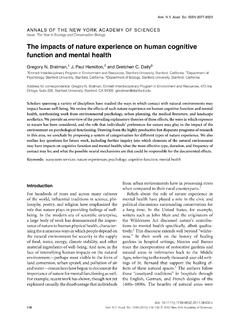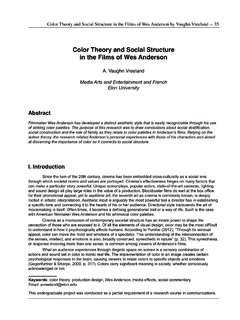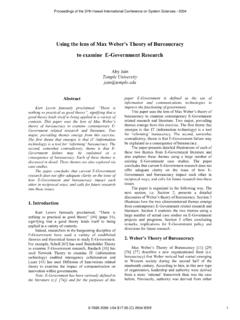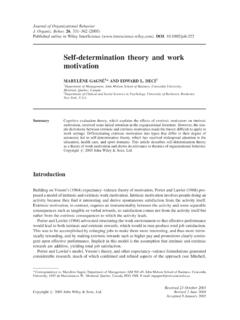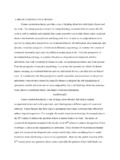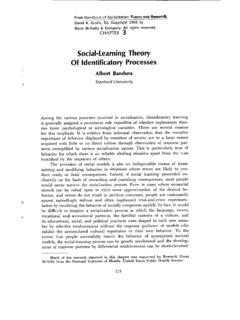Transcription of THE RESTORATIVE BENEFITS OF NATURE: TOWARD ... - …
1 Journal o/Enuinm,mfol Ps>clmlog~ (1995) 16, 169-182 B 1996 Academic Press Limited THE RESTORATIVE BENEFITS OF nature : TOWARD AN INTEGRATIVE FRAMEWORK STEPHEN KAPLAN Department of Psychology, University of Michigan, Ann Arbor-, MI 48109-1109, Abstract Directed attention plays an important role in human information processing; its fatigue, in turn, has far- reaching consequences. Attention Restoration Theory provides an analysis of the kinds of experiences that lead to recovery from such fatigue. Natural environments turn out to be particularly rich in the character- istics necessary for RESTORATIVE experiences. An integrative framework is proposed that places both directed attention and stress in the larger context of human-environment relationships. 0 1995 Academic Press Limited Introduction Evidence pointing to the psychological BENEFITS of nature has accumulated at a remarkable rate in a relatively short period of time. Whether a theoreti- cal understanding of these RESTORATIVE influences has kept pace with the empirical work is, however, less clear.
2 As Hartig and Evans (1993) have pointed out, theory in this area has been dominated by con- flicting positions, one emphasizing stress reduction (Ulrich, 1983) and the other concerned with recov- ery of the capacity to focus attention (Kaplan & Talbot, 1983; Kaplan & Kaplan, 1989). While it might be argued that these positions are hopelessly far apart, Hartig and Evans hold out hope for a syn- thesis. The purpose of this paper is to propose a way in which such an integration might be achieved. A synthesis requires first that there be something to synthesize. There must be entities or ideas dis- tinct enough and useful enough to warrant syn- thesis. One piece of this is simple to achieve; there is no disagreement over the point that stress is a meaningful concept and that stress reduction is aided by natural environment experience. Ulrich et al. (19911, however, have questioned the usefulness of the attentional concept in this context, and have suggested that the performance deficits found in research on attentional fatigue can be understood simply as effects of stress.)
3 Given these questions and alternative interpret- ation, it seems appropriate to begin by focusing on directed attention and its role in the Attention Res- toration Theory. Several studies that examine the relationship between the natural environment and restoration are then presented. This lays the groundwork for proposing an integrative framework which focuses on the causal matrix that connects stress and attention. Finally, the paper offers some directions for future research and concludes with a brief analysis of the merits of distinguishing between stress and attentional factors. Directed attention An important source for the attention constructs central to Attention Restoration Theory is the work of William James (1892). His voluntary attention concept concerned the kind of attention that went against the grain , as it were. It was to be employed when something did not of itself attract attention, but when it was important to attend nonetheless.
4 Thus James emphasized the centrality of effort in the employment of this kind of attention. Certainly the themes of voluntary and effort suggest the functioning of the will, a topic of considerable inter- est to James. And in fact, by turning to his dis- cussion of will, it is possible to &in still further insight into his thinking on this issue. In exploring 169 170 S. Kaplan how one can support a weak intention, such as a thought of something one ought to do but finds diffi- cult, James indicated that the only hope was to inhibit all distractions. There was no way, he felt, to strengthen the weak intention itself. The only sup- port one could provide required protecting it from competing thoughts. While James did not explicitly relate his dis- cussions of the will and of voluntary attention, it is evident that in both cases the central construct is that of focus, of supporting difficult mental activity in the face of potential distraction.
5 Bringing these two Jamesean themes together yields a more gen- eral mechanism than either would be separately. It also suggests an interesting and far-reaching hypothesis about the operation of this mechanism, namely that it is inhibitory in nature . Although James did not use the term inhibition , a mechan- ism whose operation depends on the suppression of competing activity must exert an inhibitory influence. An attentional mechanism that requires effort, that can be brought under voluntary control, and that depends upon inhibition for its operation offers substantial explanatory promise. James writings suggested this juxtaposition about a century ago; it is remarkable that this potentially powerful theor- etical tool has been ignored for so long. Although James emphasized the role of effort in the voluntary attention concept, he did not address the possibility that this mechanism was susceptible to fatigue. While not having as well developed a con- cept of attention, the eminent landscape architect Frederick Law Olmsted not only understood the possibility that the capacity to focus might be fatigued, he also recognized the need for urban dwellers to recover this capacity in the context of nature .
6 This was evident both in his approach to the design of parks, and, quite explicitly, in his writing as well (Olmsted, 1865). More recently, clinical neurologists, working with brain-damaged patients, have identified a remark- ably similar mechanism that they refer to as directed attention (Mesulam, 1985). Interestingly, they relate deficits in directed attention to damage to the prefrontal cortex, a portion of the brain that has long been associated with an inhibitory role in mental functioning (Rothbart & Posner, 1985). Since the concern of clinical neurologists is with rehabilitation, their emphasis is less on specific information-processing capabilities than it is on the broader issue of getting along in the world. Thus they have been particularly concerned with the role of directed attention in executive functioning , the capability necessary to lead an organized and pur- poseful life (Lezak, 1982; Stuss & Benson, 1986).
7 While inspired by James notion of voluntary attention for some time ( Kaplan, 19731, we have shifted to calling this concept directed attention as it avoids confusions others have had with James terminology (Kaplan & Kaplan, 19891. Directed attention fatigue and basic processes. Drawing together these various themes yields a mechanism with the following properties: it requires effort, plays a central role in achieving focus, is under voluntary control (at least some of the time), is susceptible to fatigue, and controls dis- traction through the use of inhibition. While the coherence and usefulness of this concept may not be immediately obvious, in fact it is quite familiar. What is familiar, however, is not the mechanism itself, but the state of mind that accompanies its fatigue. Any time one has worked intensely on a project and subsequently finds oneself mentally exhausted, one has experienced this unwelcome state. The typical state of mind of students at the end of a semester is a familiar example.))
8 In fact, even a thoroughly enjoyable project, if sufficiently intense and sufficiently prolonged, is likely to lead to this same outcome. More formally, any prolonged mental effort leads to directed attention fatigue. It might seem peculiar that a mechanism so intimately involved with human effectiveness would be so susceptible to fatigue. Yet, in evolutionary perspective, this appar- ent limitation might have been quite reasonable. To be able to pay attention by choice to one particular thing for a long period of time would make one vul- nerable to surprises. Being vigilant, being alert to one s surroundings may have been far more import- ant than the capacity for long and intense concen- tration. Further, much of what was important to the evolving human-wild animals, danger, caves, blood, to name a few examples-was (and still is) innately fascinating and thus does not require directed attention. It is only in the modern world that the split between the important and the inter- esting has become extreme.
9 All too oRen the modern human must exert effort to do the important while resisting distraction from the interesting. Thus the problem of fatigue of directed attention may well be of comparatively recent vintage. The importance of directed attention. One might wonder just how important directed attention fatigue is. Granted that scholars who need to con- centrate for long periods of time might be disadvan- The RESTORATIVE BENEFITS of nature 171 taged by this limitation. But there remains the question of how significant the fatigue of directed attention would be for people in general. It may seem unlikely that a deficiency one has never even heard of before could play a major role in human thought and human effectiveness. Nonetheless there are theoretical grounds for suspecting that directed attention fatigue can, and often does, have devastating impacts. Selection. The capacity to solve problems is often viewed as the crowning achievement of the human mind.
10 Even a cursory look at problem-solving reveals the central role of attention. Consider a mature individual approaching a problem. Such an individual has available a remarkable array of capabilities; there is considerable stored knowledge, along with a multiplicity of perceptual possibilities and a vast repertoire of possible actions. Much as these are powerful resources, most of them are irrel- evant to the solution of any particular problem. The very richness of possibilities presents a daunting challenge. Solving a problem requires a focus on the tiny portion of one s repertoire that is pertinent to the problem at hand. It is essential to select appro- priately from among the knowledge, the possible percepts, and the potential actions. Ironically, the larger the store of possibilities, the more essential is the capacity for selection. In his chapter on Reason- ing (where he treated material closely akin to what we would now call problem-solving), James (1892) both emphasized the significance of selection and illustrated it in the same passage: To me now, writ- ing these words, emphasis and selection seem to be the essence of the human mind.
